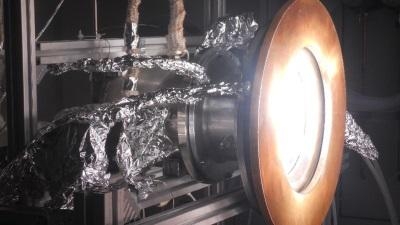SOLAR-JET 'Reverses' The Combustion Process To Produce Fuel
An international group of researchers has succeeded in producing the world's first jet fuel from sunlight, water and carbon dioxide in the SOLAR-JET (Solar chemical reactor demonstration and Optimization for Long-term Availability of Renewable JET fuel) project. Unlike conventional kerosene, produced using petroleum, the alternative fuel is based on resources that are available in almost unlimited quantities and could therefore make a significant contribution to sustainability and supply security within air transport. The project partners include the German Aerospace Center (Deutsches Zentrum für Luft- und Raumfahrt; DLR), ETH Zürich, Bauhaus Luftfahrt, Shell Global Solutions and the consulting firm ARTTIC.

"The basic idea is to reverse the combustion process. What we do is take carbon dioxide and water vapor, and introduce energy to produce fuel," explains Patrick Le Clercq, who is responsible for the project at the DLR Institute of Combustion Technology in Stuttgart. The thermochemical process used involves two steps. First, the researchers use a cutting-edge solar reactor developed at ETH Zürich to split a metal oxide, which serves as a catalyst, into metal and oxygen ions. To achieve this, it is necessary to reach high temperatures of up to 2000 degrees Celsius, which can be achieved, for example, by using solar receivers that capture and focus sunlight. Afterwards, the researchers feed carbon dioxide and water vapour through the solar reactor. The reaction with the metal and oxygen ions produces syngas, a mixture of hydrogen and carbon monoxide, each with a very high purity.
The Fischer-Tropsch method is subsequently applied to convert the syngas into kerosene. This large-scale method is already in widespread use throughout the world and has been certified for aviation purposes. This means that the fuel produced using this technique will not need to undergo any new, extensive testing and certification procedures.
The reactor, developed in the SOLAR-JET project under the direction of ETH Zurich, will be on display at the Berlin Air Show from May 20-25 on the DLR stand.

To acquire a more precise understanding of the complex processes within the solar reactor, the DLR combustion researchers used computers to simulate the innovative first process stage; to do this, they were able to draw on their long-standing experience in the field of developing and analysing alternative fuels for the aviation sector. The end product – a 'virtual' solar reactor that analyses roughly nine million individual computational operations to evaluate which thermochemical reactions will occur when, where and at what reaction rate. "These days, this kind of model is an important precondition for building test systems. It means that the project partners can plan lengthy and expensive experimental tests in a targeted manner and systematically develop the entire system of the solar reactor and the individual processes unfolding at its core," says Le Clercq.
Now that the project partners have demonstrated the feasibility of this method on a laboratory scale, they intend to progress to the next stage of further optimising the solar reactor and analysing technical and commercial feasibility on an industrial scale. The SOLAR-JET project kicked off in January 2011 and will receive four years of funding from the European Commission as part of the Seventh Framework Program.
(Images provided by DLR)
 ANN's Daily Aero-Term (06.10.24): Known Traffic
ANN's Daily Aero-Term (06.10.24): Known Traffic ANN's Daily Aero-Linx (06.10.24)
ANN's Daily Aero-Linx (06.10.24) ANN's Daily Aero-Term (06.11.24): Abeam
ANN's Daily Aero-Term (06.11.24): Abeam ANN's Daily Aero-Linx (06.11.24)
ANN's Daily Aero-Linx (06.11.24) Aero-News: Quote of the Day (06.11.24)
Aero-News: Quote of the Day (06.11.24)




